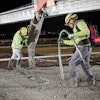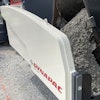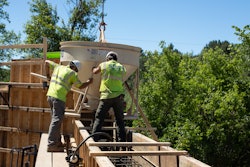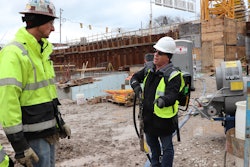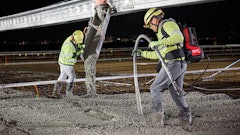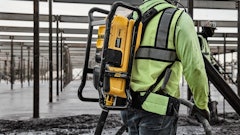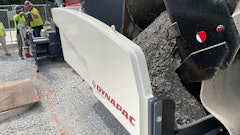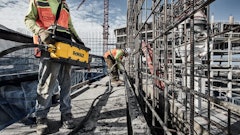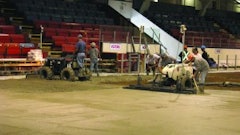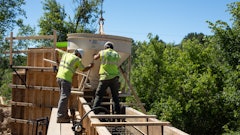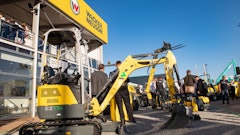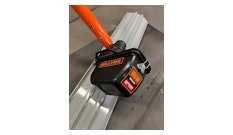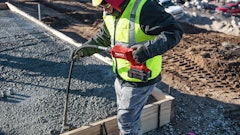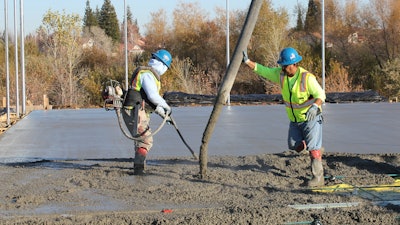
The quality of concrete can be significantly improved by vibration. The savings achieved and the improved quality of concrete are now so well established that vibration is an accepted job site practice. Internal vibrators are the most common for concrete consolidation of thick slabs, walls and columns. Because of their design, size, weight, maneuverability and price, they are a very practical means of vibration.
Typically, internal vibrators are not considered “big ticket” equipment items, but they are important to providing a quality product. Timing is the name of game and when the pour is ready, so must the contractor with the right equipment for the job.
The advantages of consolidating concrete by vibration are:
- Greater density of the concrete
- Greater strength
- Improved bond with reinforcement steel
- Greater bond on construction joints
- Greater durability
- Improved product finish
- Reduction in the amount of required cement through the use of drier mixes
The basic principal of concrete vibration is to consolidate the mix by removing entrapped air. Vibration is a series of rapid compressive impulses which greatly reduces the surface friction between the various size particles of the mix. The result is the rearrangement of these particles into a denser mass. During the vibration process, unwanted trapped air escapes to the surface.
When the vibrator is immersed in the concrete, the amplitude (circular motion) of the vibrator converts stiff concrete into a fluid, flowable mass. There is a noticeable movement of the concrete under the influence of the vibration, however it must be remembered that movement of concrete is not the primary objective, to remove air is. The concrete should be placed as near as possible to the final position and not moved along the forms with the vibrator. This will avoid segregation of the concrete mix.
More on Concrete Consolidation from ForConstructionPros.com
Controlling the Frequency of your Concrete Vibrator - This Digging Deeper Podcast episode talks about concrete vibration, what it does, why it’s important – and why you want to control the frequency.
Good Vibration = Quality Concrete - Proper use of an internal vibrator will minimize surface defects and blemishes.
How to Use an Internal Vibrator - Contractor best practices for concrete vibration techniques on concrete forming projects.
Are You Vibrating Your Concrete Too Much? - How the concrete vibrator’s design has changed since the 1960s and how the transformation has impacted the concrete industry today.
 Head selection
Head selection
Proper vibrator handling entails quickly submerging the vibrator into the fresh lift, then withdrawing it at that rate of one inch per second (never more than two inches per second). This is because air bubbles naturally rise at the same rate in normal concrete. The hole must close completely behind the vibrator after total withdrawal. If not, the mix is too stiff or the vibrator frequency is incorrect. The vibrator has done its job when a thin film of glistening “cream” appears on the surface of the concrete, cement paste rises where the concrete meets the forms, and large air bubbles are no longer surfacing. When pouring walls and columns, the concrete is typically placed in the form in 20 inch (recommended) to 48 inch layers (lifts). The vibrator head should be inserted quickly all of the way to the bottom and left there for 5 -15 seconds. It should then be slowly withdrawn bringing the entrapped air to the surface. Each lift should be vibrated; and when each following lift is vibrated the head should penetrate about six inches into the preceding layer and jigged for 5-15 seconds to bond or knit the two lifts together.
 Electric flex-shaft models are most commonly found on residential and commercial jobsites for all types of applications. Most have interchangeable heads and shafts to accommodate varying job demands.
Electric flex-shaft models are most commonly found on residential and commercial jobsites for all types of applications. Most have interchangeable heads and shafts to accommodate varying job demands.
Factors Involved
Choosing the right vibrator type for the application depends on several different factors:
- Type of pour: wall, floor, column, curb and gutter, etc.
- Height of the wall or structure
- Width of the wall or structure
- Electrical availability on the jobsite
- Electrical source distance
- Amount of reinforcing steel
- Job specifications
- Concrete slump
- Concrete mix design
There are many different types of consolidation vibration equipment available for internal consolidation. They may include electric flex-shaft vibrators, electric high-cycle vibrators, gas powered flex-shaft vibrators, and gas powered backpack modular vibrators.
Electric flex-shaft models are most commonly found on residential and commercial jobsites for all types of applications. Most have interchangeable heads and shafts to accommodate varying job demands. High-cycle vibrators are prevalent on larger jobs. They are unique in that they convert single phase (1~) energy into three phase (3~) for more consistent power while immersed in the concrete. These two types of vibrators require an electrical power source and therefore the cords must be managed by the operator to prevent damage or interference with other jobsite processes.
Gas powered internal vibrators offer versatility on the jobsites by eliminating the power cord but require gas engine maintenance. Piece work for curb and gutter, vibration at construction joints, and slab consolidation are a few good applications for a backpack vibrator. Some limitations may occur with the length of the shaft and head size with these units however. There may also be jobsite limitations regarding hazardous materials.
By asking some basic questions such as the job size and type of project will help determine which vibrator is best for the job at hand. Following these simple handling techniques will provide a quality concrete product.
About the authors
Luke Sevcik, ACI Certified Flatwork Finisher and Vince Hunt, ACI 309 Committee Member are Product application/training specialists at Wacker Neuson Corporation.

